The 100th Anniversary of the End of WWI in Belgium (No. 9)
In Belgium, November 11 is a national holiday, as it is the day when the end of the First World War is remembered. Since it also coincides with the 100th anniversary this year, it is a truly special commemoration day.
Let us look back on history a little bit.
At the time of its founding, Belgium was guaranteed neutrality by its neighboring countries. However, from the end of July 1914, when one major European country after the other was dragged into the conflict and a war broke out, Belgium was requested by Germany on August 2 to allow German troops to pass through Belgian territory. When Belgium declined this, the German army broke through the eastern border and invaded the country on August 4. The Belgian army resisted in many places, with especially fierce battles in Liege, Namur and Antwerp. However, it was no match for the German army, which was far superior in terms of both scale and equipment, and the majority of the country was occupied.
By September 1914, front lines from the western part of West-Flanders to the north of France were in a stalemate, and the German army, as well as the allied powers consisting mainly of France and the United Kingdom, both constructed trenches along the front lines and were repeatedly advancing and retreating again and again. This type of protracted warfare continued for about 4 years, resulting in vast numbers of casualties on both sides. Especially in the city of Ypres, located in the province of West-Flanders, the fiercest battles of the First World War unfolded, and besides the huge numbers of victims, the city of Ypres was completely destroyed beyond recognition.
By the autumn of 1918, Belgium was liberated gradually from the west side by the Allied powers and the Belgian army. After that, a ceasefire agreement between Germany and the Allies was concluded and the ceasefire came into effect at 11:00 am on November 11, thereby ending the First World War. However, as Belgium had been a battlefield for over four years and had been under German occupation, as well as been resisting the occupation, the outflow of the population and devastation of the country had been considerable, and Belgium needed a long time to heal its wounds of the First World War.
In this way, it can be said that the First World War had unspeakable influences on Belgium. Even today, when one talks about “La Grande Guerre” (The Great War) in Belgium, it refers to the First World War.
In the morning of November 11, a ceremony was held to commemorate the 100th anniversary since the end of the First World War, at the Place du Congres in front of the memorial column which enshrines the Unknown Soldiers in Brussels, in attendance of Their Majesties King Philippe and Queen Mathilde. Representatives from different circles in Belgium, such as the parliament, the government and the courthouses, as well as representatives from different countries, including myself, attended the ceremony.
His Majesty King Philippe paid his respects to the unknown soldiers who have died in battles for Belgium, and gave a speech in which he said that we had the responsibility to continue to tell about the memories of those who had sacrificed themselves and the values they had fought to protect until the end, requiring everyone’s involvement to build a peaceful world.
At 11 o'clock, the time the ceasefire went into effect, all the participants gave a silent prayer for the victims. After that, Their Majesties the King and Queen placed wreaths, followed by the representatives from various circles in Belgium. Unfortunately, it rained occasionally, and a cold wind was blowing at the elevated Place du Congres overlooking the city, but the ceremony was held solemnly from beginning to end. The moment was broadcasted live on TV nationwide, resulting in many citizens sharing the experience of those present.
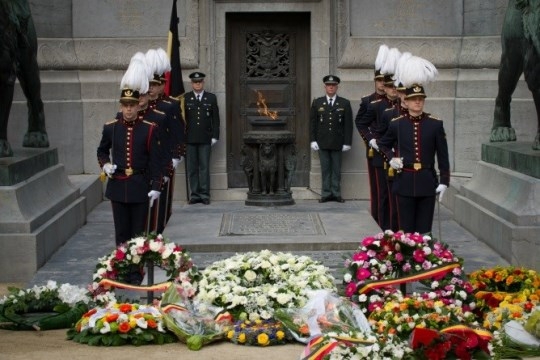
©Ritchie Sedeyn
Besides this, many other events commemorating the end of the First World War were held in many different places in Belgium, both on the Memorial Day itself as on the days before and after.
On November 9, the opening of the “Hiroshima-Nagasaki Atomic Bomb Exhibition” was held at the recently opened Yper Museum located in the center of the city of Ypres, with the cooperation of the Hiroshima Peace Memorial Museum. Present at the opening were representatives from Ypres, including Mayor of Ypres Mr. Durnez, the Director of the Hiroshima Peace Memorial Museum Mr. Shiga, and myself.
I think it is deeply meaningful that an exhibition which looks back on the historical facts of the first atomic bombings in history, those of Hiroshima and Nagasaki, was held on the special occasion of the 100th anniversary since the end of the First World War in Ypres, where fierce battles took place and where weapons of mass destruction, namely poison gas, were used for the first time in world history. I believe strongly that no matter how tragic or harsh, we need to share these facts from the past, and pass them down to future generations.
That is the thought which I shared in my speech with those present at the opening. After the ceremony, I visited together with the other attendees the exhibition room decorated with origami cranes made by the people of Ypres, to see the various exhibits which conveyed the calamities of the atomic bombings.
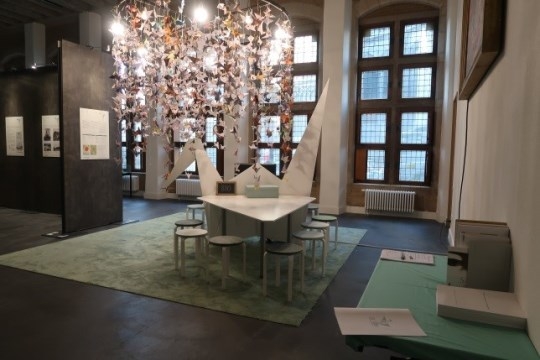 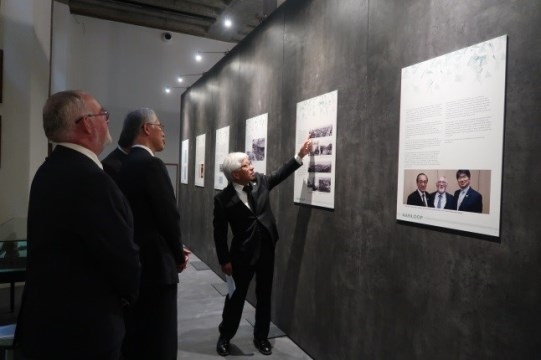
Offered by the Hiroshima Peace Memorial Museum
In the afternoon of November 11, a Peace Carillon unveiling ceremony was held in Aarschot, a city to the north-east of Brussels, located in the province of Flemish Brabant. I received an invitation from Mayor of Aarschot Mr. André Peeters, and left Brussels for Aarschot.
Aarschot was occupied without resistance by the German army in August 1914. However, the commander of the occupation forces was shot by someone. As retribution, the Mayor at the time was executed, along with 156 citizens including his own 15-year old son, and the city was set ablaze. Furthermore, all of the remaining citizens were forced to move elsewhere. As a result, the city which had existed since the Middle Ages was devastated and it took a long time for it to recover.
Last year, a plan was set up to make a peace carillon in Aarschot during the 100th anniversary of the end of the First World War, and install it in the bell tower of the Church of Our Lady in the city center. I received a request from the Mayor to add among the bells a Japanese bell, to wish for peace together with Japan. Japan has nothing to do with the tragedies that took place in Aarschot, but I agreed to the request, and my name, along with the words “Eternal Peace” in Japanese, were engraved in the bell that was added.
Following the parade by the citizens of Aarschot to celebrate the opening ceremony, the well-known carilloneur Jo Haazen, who also had performed in Japan, started his musical performance. Thereupon, the peace bell resounded nobly throughout the city of Aarschot from the towering medieval Gothic belfry.
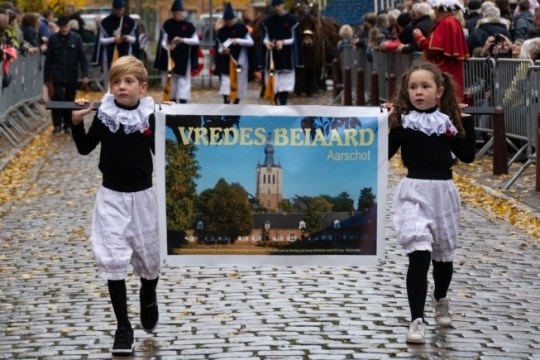 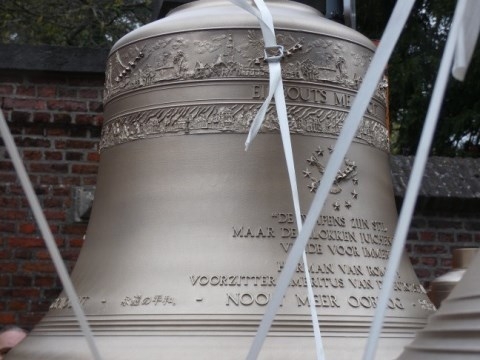
Copyright Clickshot
|

